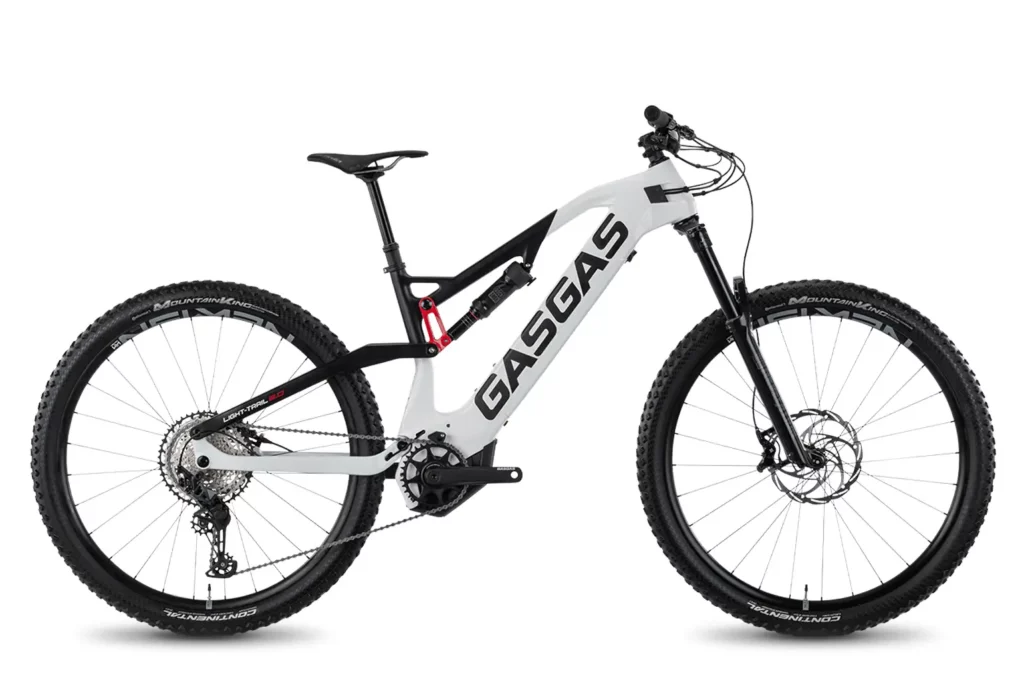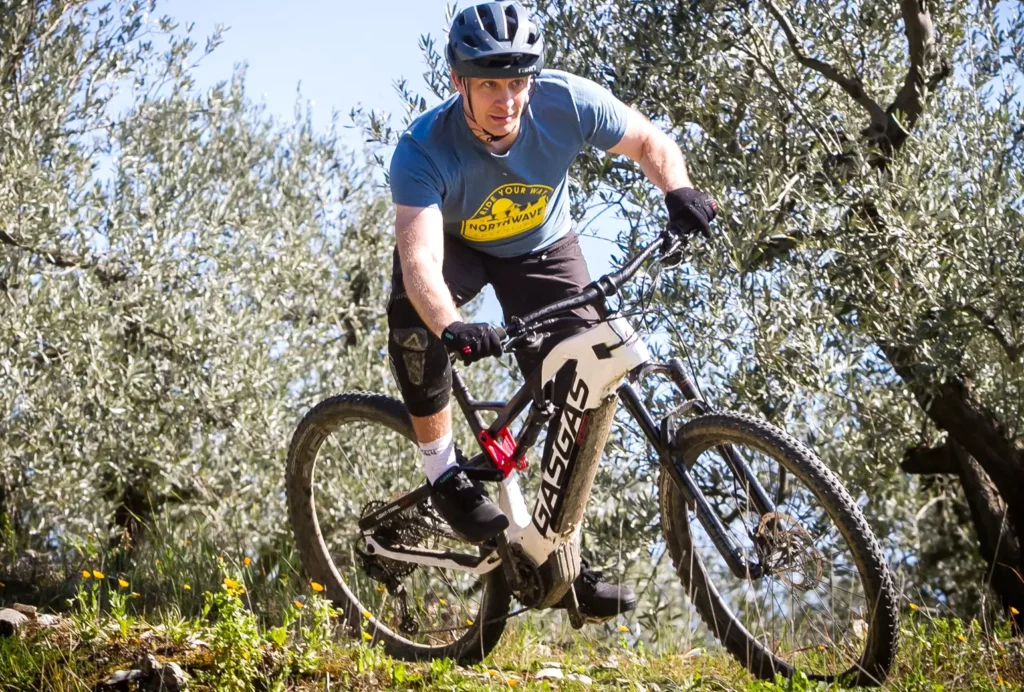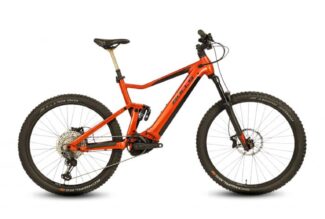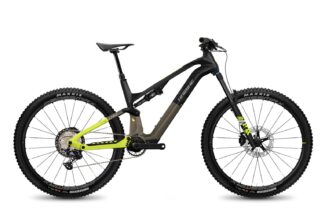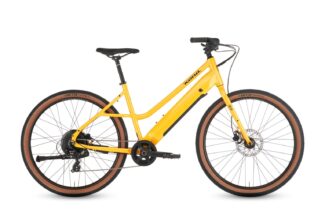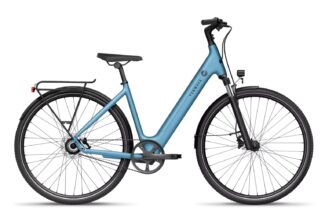Overview of the G Light Trail 2.0
Finally, we got to test the GAS GAS G Light Trail 2.0 e-bike, it’s been on our list for a while, but due to supply chain issues actually getting one has been hard. Now that we have one we are glad we did, as we get to understand a lot about what’s possible without a specialist motor.
GAS GAS uses a lightweight frame design and a normal-weight Yamaha PW-X3 motor which is called Air Drive. Honestly, we didn’t read anything about the bike before riding it and rode around thinking it was a full-power E-MTB.
That’s the point that makes this test interesting. Normally you can’t ride in parallel with other full-power e-bikes, a lightweight e-bike, but with this one, you can it seems. Checking the stats, the motor is not a full-power system but actually, a 50 Nm tune which explains the 500 Wh battery choice.
Then you look at the frame and its carbon, light, yet surprisingly normal looking. There is a lot going on here in this design. The more you dig into the frame design and look at the component package you realize that everything has been approached from a different direction optimizing available product systems and allowing GAS GAS to come in at a very competitive price.
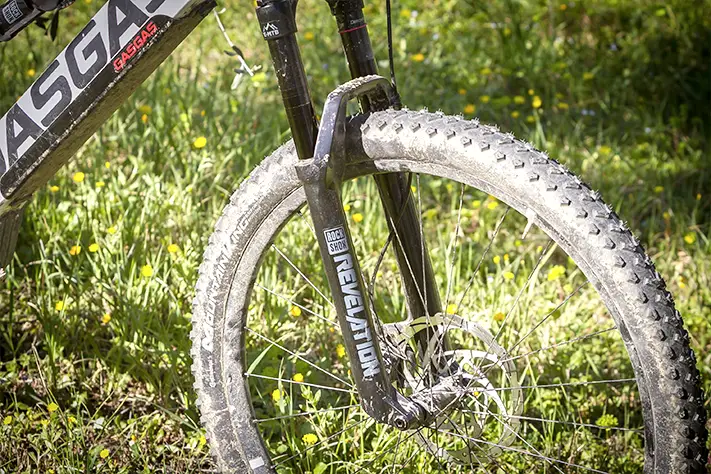
for blasting rock gardens. Credit: Alex Boyce
This is a trail bike with 29” wheels and is aimed at the lightweight category of e-bikes, therefore weight is of prime concern with our test version coming in at around 19 kilos or 41lbs.
The last point we want to convey is that GAS GAS will appeal to a significant part of the motorcycle community. Over the years of testing, we have found brand name recognition is attractive to groups of riders coming from different backgrounds into the e-bike sphere. Having this product on offer is a great introduction to the lightweight e-bike experience for such potential riders.
Best For
The G Light Trail 2.0 is perfect for trail riding and exploring with fitness as a goal for those who want quality performance, but without paying car-like prices for an e-bike.
Reasons to Buy the G Light Trail
This is a mid-range bike, it costs around $5,800 which is actually considering the package and intended use, very competitive/value for money. You normally don’t get a lightweight e-bike with a carbon frame at this price point.
Things to Consider
The motor is not a full-power motor. Thus don’t expect to keep up with the pack easily if you are doing group rides with others on e-bikes with big motors and large batteries when they are all in turbo mode all the time. It’s great for individual riders who ride alone frequently or group rides with others on lightweight e-bikes.
The G Light Trail 2.0 Components
Starting with the frame which is a distinctive box-style frame design with a removable battery, it’s light and boasts 150mm of rear travel with a Rockshox Deluxe air shock. The shock doesn’t have a lockout on it, which was surprising, but very few people actually use the lockout feature in our experience.
The fork is a Revelation RC Rockshox which is a lighter weight fork compared to what we have found on e-bikes recently and yet for trail riding duties ideal, keeping the overall bike weight lower.
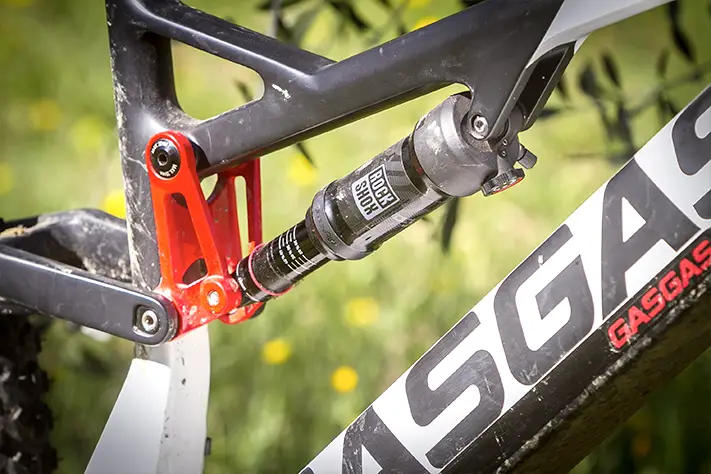
ride that is possible with this bike. Credit: Alex Boyce
Drive wise we have a Shimano SLX 12-speed drivetrain and this is where we start to be actually very impressed, not because of the drivetrain but because GAS GAS designers didn’t fall into the trap that many product managers do and spec a high-function drive and cheap out on the brakes. In this case, we find to complement the forward motion, stopping power is provided by Formula Cura brakes. These brakes worked exceptionally well and come with carbon levers, and a super plush feel and design.
The front brake has a four-piston caliper and the rear brake has a two-piston caliper with a 180mm disc. This combination was actually perfect for our setup.

best brakes available on the market. Credit: Alex Boyce
The wheelset is a lighter weight fast rolling design from Newman with Continental Mountain King tires. The tread pattern is a fast-rolling design with a rounded profile for smooth-feeling transitions in cornering.
Yamaha Motor and Battery
Yamaha is pushing hard into the e-bike category now with a competitive motor system, the PW-X3. To find a variant of it with a different software tune that is focused on gentle support rather than out-and-out power surprised us, as actually riding it felt very similar to a full-power motor.

software tune compared to the full power version. Operation is quiet
and smooth. Credit: Alex Boyce
The tune is 50 Nm which is actually more than enough for e-mtb riding even up lots of hills, backing off from the full power option that’s possible with this motor means a much more extended range from a 500 Wh battery.
During our rides, we found the battery gave us a very long range, more comparable to a 630 Wh or 700 Wh battery range expectation, because of the lower power draw.
The Air Drive motor has four power modes and a small display mounted behind the bar which conveys all the necessary information without a big screen. The remote on the left side is small in size and robust in design with a range of LEDs for power and charge level. The display is in a good position to not risk being taken out when riding off road by trail debris.
The motor feel is similar to a full-power variant but top-end power is equivalent to a mid-power mode. The range we estimate to be at around 5,000 feet (1,500 meters) of climbing or 30 miles distance depending on rider weight, air temperature, etc.
Geometry
The rider position is fairly upright with an efficient pedal angle to seat post angle ratio, thus this bike is not designed for extreme downhill. Efficiency and long distant pedaling is the key element of riding in the design.
Climbing is a comfortable sensation and directional control with the 29” wheels complemented by the bike geometry being such that the wheels are in constant contact with no front-end lift on steep sections.
Descending fast is not the idea of this bike, but possible with good bike skills. The rider position is more situated and less free to move around compared to an enduro bike, again highlighting the aim of efficiency being the direction of the intended use of this bike.
On The Trail
Off-road this bike flies along smooth gravel and undulating forest trails. It corners smoothly but is not a radical direction-changer rig. It’s basically a quiet bike that takes you along and gets you appreciating where you are whilst helping you achieve some fitness and exploring.
The Formula Cura brakes are really really good. A stand-out component which means we spent zero time thinking about braking. The power is spot on, as is modulation.
The tires are not our choice for aggressive riding but work well when reducing rolling resistance, having some grip, and maintaining a smooth feel are your aim.
On descents, it is capable and can be jumped around a bit, but needs to be looked after on rough stuff, the suspension and wheels, and tires are not designed for multiple rocks and holes with g-outs. It’s for certain a trail bike.
Takeaways from the GAS GAS G Light Trail 2.0
It’s a great bike that got a lot of positive comments on its design look. You can ride it in confidence as it has a reliable motor system that is very efficient for its use of the battery.
Riding the G Light Trail 2.0 is for those who wish to explore and ride trails without hitting gnarly rock channels. It’s more of the fitness lover’s bike, for the individual who rides alone and wants to get the km’s or miles under their belt.
You don’t need battery range extenders with this bike.
This is a mid-range bike, it costs around $5800 which is actually considering the package and intended use, very competitive/value for money. You normally don’t get a lightweight e-bike with a carbon frame at this price point.


